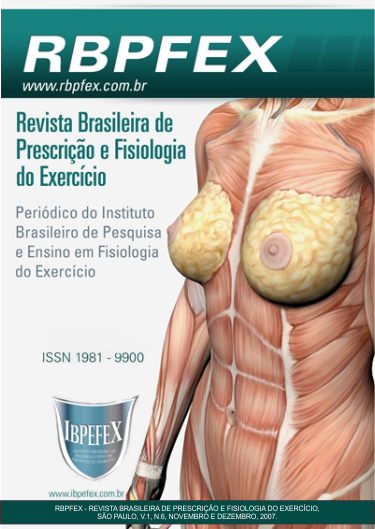Analysis of the kinetic one of lactate during a lesson of Karatê - Dô Shotokan
Abstract
The reported research purposed to analyze the lactate dynamics during a karate–Do class and confront it with the class objectives. The appraised group was composed by three shotokan Karate-Do practices, from 18 to 25 years old and with 18 months practicing at least at this modality. The material utilized in order to mesure the blood lactate was a Lactímetro Accutrend Lactato Roche.In order to determine the class objective a questionnaire was utilized. Considers that blood lactate answers to exercises have been widely applied in the effort intensity prescription and in order to establish the exercises intensity domain limits (temperate and intense). The lactate level increasing up to 4 mmols rate shows that this activity consumes as an important performancing raw anaerobic glycolise. This research showed that is necessary to invest on researches with a numerically superior group in order to determinate other classes’ intensity with other classes’ intensity with other objectives. It`ll start a development according to Sport training principles, organizing each class in consonance with its objectives and respecting the intensity level agreeable to the trained physical capacities.
References
- Bompa, Tudor O. Periodização: teoria e metodologia do treinamento. 4.ed. São Paulo: Editora Phorte, 2002.
- Brunetto, Antônio Fernando.; e colaboradores. Limiar ventilatório e variabilidade da freqüência cardíaca em adolescentes. Rev Bras Med Esporte., Niterói, v. 11, n. 1, 2005.
- Denadai, B.S.; e colaboradores. Avaliação aeróbia: determinação indireta da resposta do lactato sangüíneo. Motrix, Rio Claro, 2000.
- Denadai, Benedito Sérgio.; e colaboradores. Efeito da cadência de pedalada sobre as respostas metabólica e cardiovascular durante o exercício incremental e de carga constante em indivíduos ativos. Rev Bras Med Esporte., Niterói, v. 11, n. 5, 2005.
- Funakoshi, Guichin. Karate – Do Nyumon. 9º ed. São Paulo: Editora Cultrix, 1988.
- Lima, Elessandro Váguino de.; e colaboradores. Estudo da correlação entre a velocidade de reação motora e o lactato sanguíneo, em diferentes tempos de luta no judô. Rev Bras Med Esporte., Niterói, v. 10, n. 5, 2004.
- Pitanga, Francisco José Godin. Testes, Medidas e avaliação em Educação Física. 4.ed. São Paulo: Editora Phorte, 2005.
- Platonov, Vladmir Nicolaiev. A preparação Física, Rio de Janeiro: Sprint, 2003.
- Powers, S.; Howley, Fisiologia do Exercício: Teoria e Aplicação ao Condicionamento e ao Desempenho. 1º ed. São Paulo: Editora Manole, 2000.
- Ratti, Oscar. As Artes Marciais no Japão feudal.1º ed. São Paulo: Editora Madras, 2006.
- Rocha, Paulo Eduardo Carnaval Pereira da. Medidas e Avaliação em Ciências do Esporte: Rio de Janeiro: 6º edição: Editora Sprint, 2004.
- Silva, Luiz Roberto Rigollin. Treinamento com crianças e adolescentes. 1º ed. São Paulo, Phorte, 2006.
- Weineck, Jurgen. Treinamento Ideal: instruções técnicas sobre desempenho fisiológico incluindo construção específica de treinamento infantil e juvenil: 9º edição, Manole, 1999.
- Zacharov, Andrei Anatolovitch. Ciência do Treinamento Desportivo. 2º ed. Grupo Palestra, 2003.
Authors who publish in this journal agree to the following terms:
- Authors retain the copyright and grant the journal the right of first publication, with work simultaneously licensed under the Creative Commons Attribution License BY-NC which allows the sharing of the work with acknowledgment of the authorship of the work and initial publication in this journal.
- Authors are authorized to enter into additional contracts separately for non-exclusive distribution of the version of the work published in this journal (eg, publishing in institutional repository or book chapter), with acknowledgment of authorship and initial publication in this journal.
- Authors are allowed and encouraged to post and distribute their work online (eg, in institutional repositories or on their personal page) at any point before or during the editorial process, as this can bring about productive change as well as increase impact and impact. citation of published work (See The Effect of Free Access).






